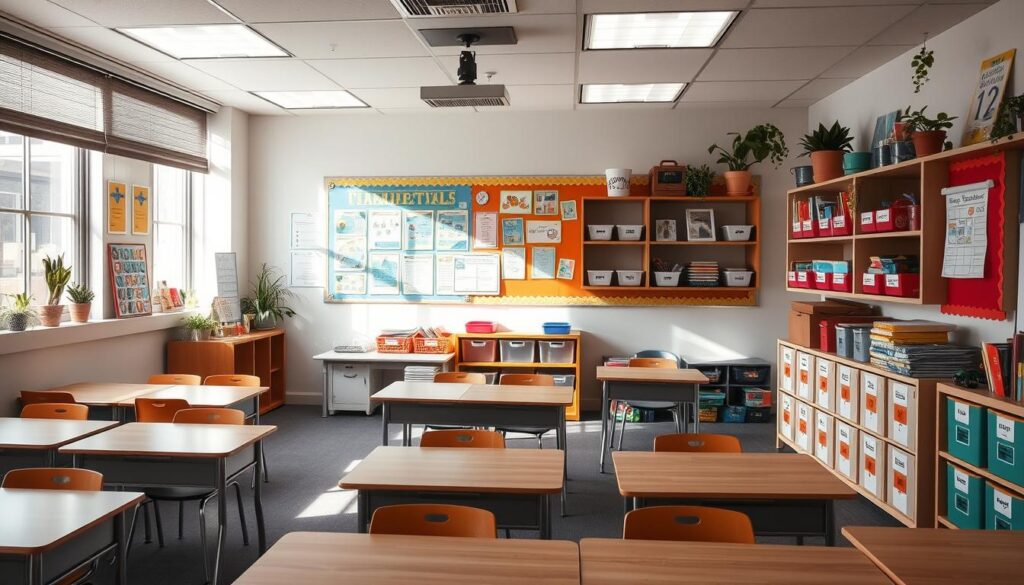The Learning Process: Key Principles You Need to Know
Understanding the learning process is key to getting knowledge and skills. It helps you reach your educational and personal goals. We’ll cover the main ideas, strategies, and techniques for learning well. By learning these, you’ll become a more active and self-directed learner.
You’ll be able to handle complex information better. You’ll turn it into useful knowledge you can apply.
فهرس المقالة
Understanding the Fundamentals of Learning Process Principles
To do well in learning, you need to know the basics. This part talks about the science of learning and what makes learning effective.
Defining Core Learning Components
Learning is complex and has many parts. It includes cognitive strategies, which are how you think about and remember info. It also includes active learning, where you actively work with the material, not just listen to it.
The Science Behind Knowledge Acquisition
The brain is amazing and controls learning. It uses constructivism to build new knowledge from what you already know. This way, you can always learn more and understand things better.
Building Blocks of Effective Learning
- Setting clear goals for what you want to learn
- Practicing and recalling what you’ve learned
- Linking new info to what you already know
- Using different ways to learn and strategies
- Checking how well you’re learning and thinking about it
Knowing these basic learning principles helps you use better cognitive strategies. It lets you be more active in your learning and use constructivism to get the most out of school.
“The greatest enemy of knowledge is not ignorance, it is the illusion of knowledge.” – Daniel J. Boorstin
How Your Brain Processes New Information
Learning new things is a complex process that involves many parts of your brain. It starts with encoding, then moves to storage and retrieval. This journey is key to understanding and keeping information.
When you learn something new, your brain first takes in the information through your senses. This is the start of processing. As you work with the new info, it moves to your working memory. There, it connects with what you already know.
The idea of scaffolding is important here. It helps your brain build on what you already understand. By linking new info to what you know, your brain can store it better. This makes it easier to use what you’ve learned later.
Using the right cognitive strategies can help your brain even more. Techniques like active recall and spaced repetition strengthen your brain’s pathways. This makes it easier to remember and use what you’ve learned.
“The brain is like a muscle – the more you use it, the stronger it gets.” – Unknown
Knowing how your brain learns can help you study better. It lets you tap into your brain’s amazing ability to grow and adapt.
The Role of Metacognition in Learning

Metacognition is the skill of knowing and managing your own thinking. It’s key to learning and growing. By using metacognition, you can achieve more in school and in life.
Self-Reflection Strategies
Learning well starts with knowing yourself. Take time to think about what you like to learn, what you’re good at, and what you need to work on. Try keeping a journal or using special questions to help you think.
Monitoring Your Learning Progress
Check how well you understand things by using formative assessment methods. This could be self-testing, practicing with others, or talking about what you’ve learned. It helps you see what you don’t know and change how you study.
Adjusting Study Techniques
Change your study ways as you learn more. Try out different metacognitive methods like remembering things by making them active, using them over time, or explaining them in detail. Always be ready to improve how you learn.
“Metacognition is not just a useful skill – it is essential for effective learning and problem-solving in the 21st century.”
Using metacognition makes you a better learner. You become more aware, flexible, and ready for any challenge in school.
Active Learning Strategies for Better Retention
Effective learning happens when you actively engage with the material. Using active learning strategies can boost your retention and deepen your understanding. These methods follow the constructivism approach, where learners build their own knowledge by interacting with the subject.
Knowledge transfer is a key active learning method. By linking new concepts to what you already know, you can better integrate and apply the information. This leads to a deeper understanding and better retention.
- Practice Retrieval: Regularly testing your knowledge through practice quizzes, flashcards, or self-generated questions can strengthen your recall and solidify your understanding.
- Engage in Discussions: Discussing the material with peers or instructors encourages you to verbalize your thoughts, clarify misconceptions, and deepen your comprehension.
- Create Visualizations: Transforming information into diagrams, mind maps, or other visual representations can help you make sense of complex ideas and cement your learning.
- Apply What You Learn: Seeking opportunities to apply your newfound knowledge in real-world scenarios or case studies reinforces the active learning process.
By using these active learning strategies, you can unlock your full learning potential and achieve lasting knowledge transfer.
| Active Learning Technique | Benefits |
|---|---|
| Retrieval Practice | Strengthens recall, solidifies understanding |
| Peer Discussions | Encourages verbalization, clarifies misconceptions |
| Visualization | Facilitates comprehension of complex ideas |
| Real-World Application | Reinforces learning and knowledge transfer |
Remember, active learning is a powerful way to improve your retention and understanding. Use these strategies to unlock your full learning potential.
“The essence of active learning is to engage the learner in the process of knowledge construction.”
The Power of Knowledge Transfer in Education
As you explore the world of learning, understanding knowledge transfer is key. This process links your past knowledge to new info. It helps you grasp subjects better.
Connecting Previous Knowledge to New Concepts
When you learn something new, your brain tries to connect it to what you already know. This connection makes learning easier and more effective. It’s a key part of learning well.
Real-World Application Methods
- Using what you know in real-life situations helps you learn better and remember more.
- Doing hands-on activities, solving problems, or studying cases makes abstract ideas real.
- This method not only helps you remember but also boosts your critical thinking and problem-solving skills.
Cross-Disciplinary Learning Benefits
Learning across different subjects can also be powerful. It lets you see connections between unrelated ideas. This way, you get a deeper understanding of the world.
| Benefit | Description |
|---|---|
| Cognitive Flexibility | Learning across subjects makes you think better, adapt faster, and solve problems from different angles. |
| Innovative Thinking | Mixing knowledge from various fields can spark new ideas and solutions. |
| Deeper Understanding | Exploring connections between subjects gives you a richer, more detailed understanding of complex topics. |
By using knowledge transfer, scaffolding, and constructivism in your learning, you open up many possibilities. You become more flexible, adaptable, and insightful.

Scaffolding: Building Strong Learning Foundations

In education, scaffolding is key in helping learners succeed. It offers temporary help, building their skills until they can do it alone. This method is crucial for students to master new tasks and ideas.
Active learning uses scaffolding to break down big goals into smaller steps. Teachers guide and support students, helping them learn on their own. This approach encourages students to take charge of their learning.
Scaffolding support changes as students get better. It starts with a lot of help and slowly gives more freedom. This way, students learn to solve problems, think critically, and learn by themselves.
Effective scaffolding includes:
- Clear, step-by-step instructions
- Visual aids or models for key concepts
- Encouraging peer-to-peer collaboration and group work
- Formative assessments to check understanding
- Adjusting challenges based on each learner’s needs
Using scaffolding in the classroom helps students feel supported. It promotes active learning and self-regulated learning. This way, students become confident and ready to face harder challenges.
“Scaffolding is the support given to a student by an instructor or peer to perform a task that the student otherwise could not perform alone to the same degree of quality.”
Developing Self-Regulated Learning Habits
Learning to manage your own learning is a big step towards success. By learning about self-regulated learning, you can control your learning. This makes you a better and more efficient student.
Time Management Techniques
Good time management helps you stay focused and reach your goals. Use strategies like making a study plan, setting priorities, and avoiding distractions. This boosts your learning productivity.
Goal Setting and Achievement
Setting clear goals is the first step in metacognition and self-regulated learning. Break big goals into smaller steps. Use formative assessment to check your progress often.
Maintaining Learning Motivation
Keeping motivated is hard, but it’s key for success. Celebrate your small achievements and reward yourself. Make learning fun and engaging.
By making these habits part of your daily life, you’ll become more confident and successful. Remember, your potential is in your hands. Take charge of your learning journey.
| Time Management Techniques | Goal Setting and Achievement | Maintaining Learning Motivation |
|---|---|---|
|
|
|
“The key to unlocking your full potential lies in your ability to take charge of your own learning journey.”
Essential Components of Constructivist Learning
Constructivism is a learning theory that puts learners at the center. It says people build their own knowledge through experiences and interactions. This approach helps create a learning space that encourages active learning and knowledge transfer.
At the core of constructivism is the importance of prior knowledge. New information works best when it connects to what learners already know. This way, learners can understand and apply new concepts actively, not just passively.
Social interaction is also key in constructivist learning. Learning is better when done with others. Through discussions and group work, learners can challenge their views, explore new ideas, and deepen their understanding.
This approach also values learning in real-world settings. It’s not just about memorizing facts. It’s about using knowledge to solve real problems and connect ideas across subjects.
By following constructivist principles, you can empower students to be active learners. This approach boosts active learning and helps develop critical thinking, problem-solving, and lifelong learning skills. These are crucial for success in today’s fast-changing world.
| Key Principles of Constructivist Learning | Description |
|---|---|
| Prior Knowledge | New information is integrated with the learner’s existing knowledge and experiences. |
| Active Learning | Learners actively construct their understanding through hands-on activities and exploration. |
| Social Interaction | Learning is enhanced through collaboration, discussion, and the exchange of ideas. |
| Knowledge Transfer | Learners apply their knowledge to solve real-world problems and make connections across disciplines. |
“Constructivist learning environments should provide opportunities for learners to interpret, analyze, and predict information based on their prior experiences and existing knowledge.”
Maximizing Your Learning Environment
Creating the best learning environment is key for success and growth. Focus on your physical space and digital tools. This will improve your learning process principles, active learning, and self-regulated learning skills.
Physical Space Optimization
Choose a spot for learning that’s free from distractions. Make sure it’s well-lit, comfy, and organized. Use furniture that supports good posture to avoid discomfort during long study times.
Digital Learning Tools Integration
Use digital tools to make learning easier. Look into online platforms, educational apps, and virtual tools that fit your style. Add these to your study routine to boost active learning and self-regulated learning.
Creating Effective Study Schedules
- Make a study plan that fits your daily life and learning needs.
- Include breaks and fun activities to keep a balance and avoid burnout.
- Try different time management methods, like the Pomodoro technique, to be more productive.
By improving your learning space, using digital tools, and making a good study schedule, you can reach your full learning potential. This will help you with active learning and self-regulated learning.
“The environment shapes the way we think and learn. Crafting an optimal learning space is the first step towards academic excellence.”
Overcoming Common Learning Obstacles
Learning can be tough, but you can beat common challenges. Using metacognition, or knowing how you learn, helps a lot. It lets you spot and fix problems.
Building self-regulated learning skills is crucial. This means managing your time well and setting clear goals. Also, doing formative assessment helps you see how you’re doing. You can then change your study methods if needed.
Having a growth mindset is important too. It means seeing challenges as chances to get better. With the right mindset and strategies, you can tackle learning with confidence. You’ll reach your educational goals.
FAQ
What are the fundamental principles of the learning process?
The learning process is guided by key principles. These include cognitive strategies, metacognition, and active learning. Also, knowledge transfer, scaffolding, and self-regulated learning are important. These principles help in effective learning and skill development.
How does the brain process new information during learning?
The brain processes new information through complex processes. Cognitive strategies like elaboration and organization help. They make it easier to integrate new knowledge.
What is the role of metacognition in the learning process?
Metacognition is crucial for effective learning. It involves self-reflection and adjusting study techniques. This helps in optimizing the learning experience.
How can active learning strategies improve knowledge retention?
Active learning strategies like problem-solving and questioning engage learners deeply. This engagement leads to better retention and understanding of information.
What is the significance of knowledge transfer in education?
Knowledge transfer is key for educational success. It involves applying learning to new situations. This connects previous knowledge to new concepts and enhances learning outcomes.
How does scaffolding support the learning process?
Scaffolding provides temporary support to learners. It helps them progress towards independent mastery. It promotes active learning and the development of strong learning foundations.
What are the key components of self-regulated learning?
Self-regulated learning involves time management and goal-setting. It also includes maintaining learning motivation. These skills help learners take an active role in their learning process.
What are the principles of constructivist learning?
Constructivist learning theory emphasizes building knowledge actively. Learners connect new information to their existing knowledge. This approach promotes active engagement and knowledge transfer.
How can you optimize your learning environment?
To optimize your learning environment, create a conducive study space. Use digital learning tools and develop effective study schedules. These strategies enhance your learning process.
How can you overcome common learning obstacles?
Overcoming learning obstacles requires metacognitive skills and self-regulated learning techniques. Ongoing formative assessment helps identify and address challenges. This improves learning outcomes and develops effective strategies.






